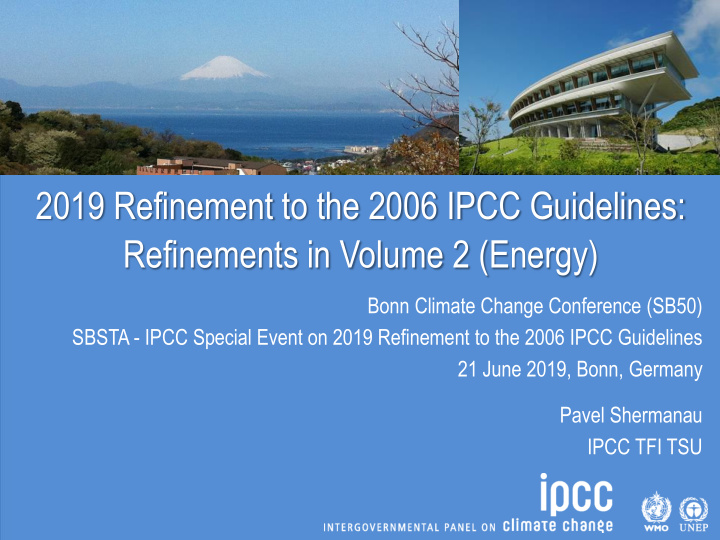



2019 Refinement to the 2006 IPCC Guidelines: Refinements in Volume 2 (Energy) Bonn Climate Change Conference (SB50) SBSTA - IPCC Special Event on 2019 Refinement to the 2006 IPCC Guidelines 21 June 2019, Bonn, Germany Pavel Shermanau IPCC TFI TSU
What is Energy Sector? Transmission Conversion of Use of fuels Exploration primary energy and in stationary and distribution of sources into more and mobile exploitation of fuels useable energy applications primary forms in refineries energy and power plants sources
Energy Sector
Mandate for Refinement (Energy) Chapter 2. Stationary Combustion • Link to issue related to biomass combustion and methodologies for Harvested Wood Products (HWP) Chapter 4. Fugitive Emissions o 4.1 Fugitive emissions from mining, processing, storage and transportation of coal • Elaborate chapter to include guidance on emissions from exploration and CO 2 emissions (Underground coal mines, Surface coal mining) • Include new section on abandoned surface coal mines o 4.2 Fugitive emissions from oil and natural gas systems • Update chapter including update/inclusion of EFs representative for current practice. Additional guidance for unconventional oil and gas production and abandoned wells. o 4.3 Fuel transformation [New] Note. All methodological updates made in the 2019 Refinement are in the fugitive emissions categories. No methodological updates were made for stationary combustion, mobile combustion, or other sources other than fugitives. Decision IPCC/XLIV-5 IPCC-44, Bangkok (Thailand), October 2016
Energy: Share of Fugitive Emissions Inventories of Annex I countries - Energy Sector (based on the 2006 IPCC Guidelines) : • Stationary Combustion ~90% (mainly CO 2 ) • Fugitive Emissions ~10% (mainly CH 4 ) • Carbon Capture and Storage (CCS) ~0% UNFCCC GHG Data Interface: https://di.unfccc.int
Coal: Sources and Gases o Guidance and emission factors for CO 2 for underground and surface mines were developed o CH 4 emission factors for abandoned underground coal mines were updated Emission Sources 2006 IPCC Guidelines 2019 Refinement CO 2 CH 4 CO 2 CH 4 1B1ai Underground Mines + + + - Abandoned + + 1B1aii Surface Mines + + + - Abandoned (new) - Appendix - Appendix 1B1aiii Exploration (new)
Oil and Gas o More structured sub-categories (segments) and emission factors with illustration of key segments in Figure 4.2.0 (see next slide) o No sub-divided categories and emission factors for venting and flaring (as in 2006 IPCC Guidelines ). Factors presented are inclusive of venting, flaring, and leak emissions. Data for venting, flaring and leaks is provided in an annex o The guidance and default emission factors for fugitive emissions were updated to reflect the range of technologies and practices in use, including for unconventional oil and gas exploration o No disaggregation of emission factors by developing and developed countries (as in 2006 IPCC Guidelines ) o Additional guidance (methods and emission factors) for abandoned oil and gas wells
Figure 4.2.0 (New) Key segments included in oil and natural gas systems
Fuel Transformation. Only Fugitives o New Category o Guidance is provided on: • Solid to solid transformation processes (charcoal/biochar production; coke production) • Gasification transformation processes (coal to liquids; gas to liquids). o Appendix: wood pellet production, biomass-to-liquid and biomass-to-gas o Cross-references to IPPU and AFOLU Sectors o Biogenic fugitive CO 2 should be reported as memo item
New 2019 Energy Structure
Conclusion o Refinement was focused on Fugitive Emissions. Stationary and Mobile combustion and CCS sources are unchanged. So the structure is practically the same. Main categories are already covered in 2006 IPCC Guidelines o More complete coverage of sources and gases in 2019 Refinement o Updated emission factors and streamlined guidance o Fuel Transformation is a new category with previously known sources of coke and charcoal production; some categories are completely new (coal-to-liquids and gas-to-liquids) o Some emission sources are for future methodological development (abandoned surface mines, coal exploration, fugitives from wood pellets, biomass-to-liquid and biomass-to-gas)
Thank you https://www.ipcc-nggip.iges.or.jp/index.html
Recommend
More recommend